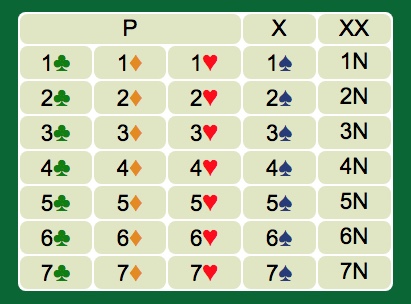015-019: Absolute Beginners - Play and Learn
015 – Bridge Game – An Overview
Bridge Game Overview
The following is a brief overview of how to play Bridge. Don’t worry too much if you don’t follow it all now, we’ll have a closer look at how Bridge is played in later lessons.
Watch video of a game - *Audio - turn your sound on
Partners and Players
How to Bid your hand
The biddingThis term is also called the ‘auction.’ In each online deal, a player is the nominated as the dealer -this title rotates each new game. The dealer is the player who starts the bidding even if its a pass. Players take their turn at bidding in turn and in order … More phase is an auction where each player gets to estimate how many rounds they think they and their partner can win. If they winner of the auction then achieves their target they win the game and gain points and the opposition loses points. If the winner of the auction fails to achieve their target then they lose points and the opposition gains points

Playing your hand
Instant Progress Quiz - Check the correct answer
Play Your First Game of Bridge
Click the ‘Play’ button below to play your first Bridge game. You will find instructions below the game. Don’t be too concerned if you don’t understand all that is happening, it will all become clearer as you progress through the lessons.
The lesson suggests that S bid 1D in response to 1C opening bid. With 10 HCP’s and a 4-card major, why not bid 1S?
You need a 5-card major.
You should bid the lower 4-card first.